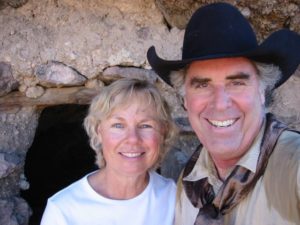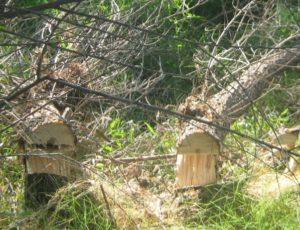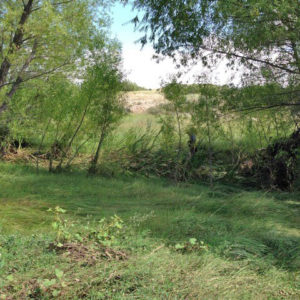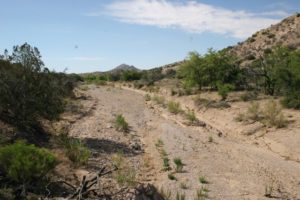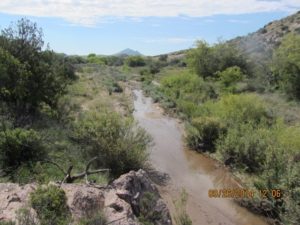The Pitchfork Ranch lies just west of the Continental Divide, about an hour south of Silver City in southwestern New Mexico. The 5,100-acre ranch of mostly rolling Chihuahuan grassland, all under conservation easement now held by NMLC, has been in continuous cattle production for over a century.
The Burro Ciénaga is a significant riparian zone and the ranch’s major feature. Defined as “slow moving water, marsh or swamp” in Spanish, the “ciénaga” is perennial and bisects the ranch from north to south. This corridor is habitat for many plant and animal species, including deer, javelina, coatimundi, golden eagle, great horned owl, and many more. The current landowners have invested this chapter of their lives and substantial resources in restoring the property, particularly the ciénaga and associated riparian area, while maintaining agricultural activities on the ranch. The following story is edited from a recent NMLC film interview with the ranch owners.
How it all started
In their younger years, A.T. and Cinda Cole did a lot of backpacking and outdoor volunteer work for various nonprofits. “We decided that we wanted to preserve some remote land of our own ─ that was our retirement plan,” says A.T., “but as soon as we retired, we found out quickly that the ‘remote land’ for sale mostly meant cattle ranches, so we bought the Pitchfork Ranch in 2003 and moved here in 2004.”
Immediately after purchasing the property, “We put a conservation easement on it,” A.T. said. “It was important to us to preserve this land and to avoid the fragmentation that’s happening to the Southwest. From our perspective, that’s one of the reasons why keeping cattle ranching alive in the southwest is so important ─ not stockyards, but cattle ranching ─ because it avoids the fragmentation.”
In addition to helping keep properties intact, conservation easements are critical in preserving the time, effort and resources invested in the restoration. “And the tax benefits are pretty remarkable,” A.T. adds. “The government has really made an effort by to encourage habitat restoration [and protection of agricultural production and our future food supply], by virtue of conservation easements, and there’s money to be realized.”
With the easement in place, the couple started restoration work in earnest in 2005. Since then, the Coles have applied for and been awarded 14 grants that they’ve used for various projects. Restoration of the Ciénaga is their primary focus. A.T. explains, “There are only 155 known ciénagas in the entire southwest, and we have one on a ranch, so we’re restoring it. That’s the core idea. But then there are 32 side channels that drain into the ciénaga, and so we’ve got to commit to getting funding to restore those as well.”
As a side benefit, A.T. points out that they’ve hired local young people to help do the restoration work, providing them an income source as well as an education opportunity.
And of course, there’s the benefit to wildlife. As part of the restoration work, the Coles have worked with state and federal agencies to reintroduce a few endangered or threatened species such as the Chiricahua Leopard Frog and the Aplomado falcon.

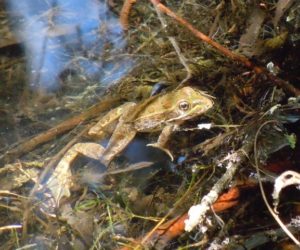

(above: Viceroy butterfly, a Chiricahau leopard frog, and a coitimundi)
“We’re feeling the effects of climate change,” A.T. says, definitively, “and I know that there are people who are skeptical about it, but it’s very real to us here ─ there’s no question about it. We’ve lost 15 to 20 percent of our juniper trees, and we’ve had two of our six wells go dry this year. Our neighbor has lived here 76 years now, and he told us that well has never been dry. When we moved here there wasn’t a dead juniper on this ranch ─ we hadn’t lost any naturally, and now 15-20 percent are gone. So, this climate change thing that we’re contending with, we’re seeing it in a lot of different ways.”
Before and After Restoration
A.T. has been consistently maintaining photo records at 11 specific points along the ciénaga every year for 13 years, which illustrate the changes that have occurred from their restoration work.
“We’ve hardly planted anything,” he says, pointing to the now-lush vegetation along the recovering ciénaga. “This is just from bringing the water back, because the water is the key.”
One of the restoration techniques A.T. employs is called hinge felling (photo right) – an inexpensive way to install a grade control structure. “Two guys can do it,” he says. “We’ve cut this tree [willows and cottonwoods] in half, and then pushed it down over the water course. Eventually the branches end up being new trees, and when there’s a flood or even now when the water is at low flow, in effect you’ve got a perpetual grade control structure; a place to capture detritus and soil, which in turn slows the water down.”
The effect is remarkable. “When we moved here, there was nothing over there,” A. T. says, pointing to vegetation so green and thick you can hardly walk through it. “There was just a creek-like water course and a little bit of growth of a few trees, but they weren’t very tall.
Now there’s this ceiling of vegetation all the way across the flood plain.”
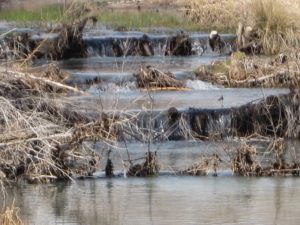
A picture’s worth a thousand words
“The reason we moved here was to do restoration,” A.T. concludes, “and we hope ─ we would like for other people to get equally as enthusiastic about what we’re doing here and to do it themselves.”
The results on the Pitchfork Ranch are influencing others. NMLC recently completed a conservation easement on the neighboring Prevost Ranch, which can be seen from the Coles’ property, thereby adding permanent protection for another 7 miles of conserved ciénaga, its floodplain and associated riparian areas to the section already restored by the Coles.
“This is really exciting,” A.T. adds, “because how many places are there in the desert southwest that have this kind of vegetation!”
(Photos above: top: hinge felling; below: a step-down water weir)
Before & After demonstrations of restoration
The Coles have been taking same-location photographs at 11 specific points along the ciénaga every year for 13 years to demonstrate the changes that have occurred from their restoration work.
Cinda Cole explains, “There are only 155 known ciénagas in the entire Southwest, but even that small number of arid land ciénagas is easily misunderstood, because only 70 of the 155 are functional or restorable; the other 85 are either dead or beyond repair. And some of the ciénagas that still have water, like this one, are incised and function like a creek. Absent restoration, they would continue to incise and eventually dry up, like the 85 others already lost. In contrast, the bed of this ciénaga has been raised as much as four feet in some reaches, and at least two feet throughout the entire nine miles.”
Photos below, courtesy of A.T. and Cinda Cole
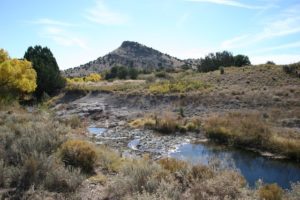
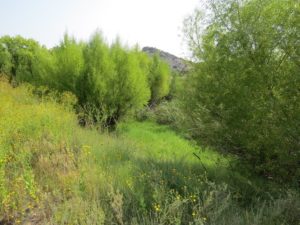
Before & After (above): The water visible in 2005 (LEFT) was an olympic-pool size straight-away, which rushed all the water out of the area when it rained. Same location in 2017 (RIGHT) after years of restoration work, using grade control structures and hinge felling, the ground through there is even, and a lush riparian area now holds water and provides habitat for a variety of species.
Before & After (above): In 2005 (LEFT) this area had been used as a rough track through the property. Using step-down water weirs and hinge felling, the ground has been raised and leveled off, and is now (2017) thick with trees and lush vegetation (RIGHT).
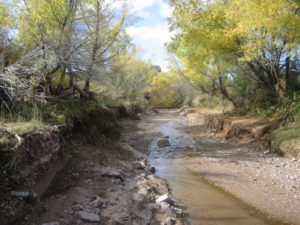
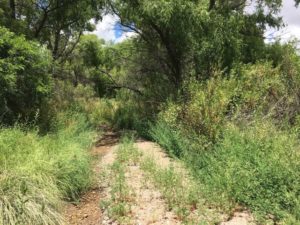
Before & After (above): The 2005 photo (LEFT) shows a 2+ foot vertical wall that had been cut away over time. Using grade control structures, the land is now filled in (2017 RIGHT), and the vegetation is thick and dense, and functioning as a healthy riparian area.

